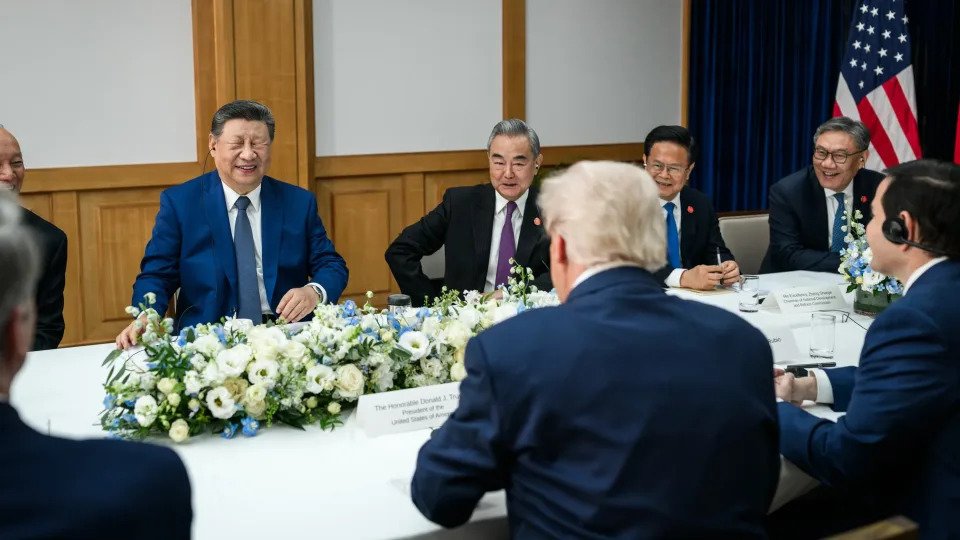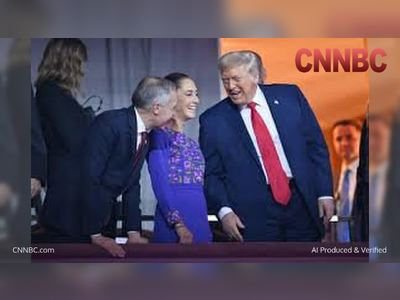
White House Releases Rare Candid Images of Xi Jinping Amid U.S.–China Diplomacy at APEC
Photographs of Chinese leader showing relaxed yet unseen moments spark interest as U.S.–China engagement deepens in Busan
The White House has publicised a series of images featuring Chinese President Xi Jinping in informal settings that are rarely shown in his home media environment.
The photographs emerged following a high-level meeting between Xi and U.S. President Donald Trump at the Asia-Pacific Economic Cooperation (APEC) summit in South Korea.
One notable image shows Trump extending his arm across a negotiation table to present Xi with a document.
In another, Xi appears smiling broadly with foreign minister Wang Yi laughing by his side—an expression of levity seldom visible in state-controlled Chinese media presentations.
The timing of the photo release is significant.
It coincides with the U.S.–China leaders reaching agreement on key economic and trade issues during the Busan summit, including a decision to reduce tariffs and address critical supply-chain concerns.
The images serve a dual purpose: they project a softer, more approachable side of Xi while also reinforcing the U.S. narrative of effective diplomacy under Trump’s leadership.
Media observers note that the images contrast strongly with domestic coverage in China, which tends to portray Xi in tightly scripted, stoic poses or formal military attire.
Analysis of social media platforms within China—such as Douyin and Xiaohongshu—reveals minimal circulation of the images, largely because Western news sites and unfamiliar social-media content remain blocked or heavily filtered.
By sharing this imagery, the White House may be engaging in a broader strategy of visual diplomacy—an effort to shape perceptions of the bilateral relationship at a moment of coordinated economic engagement.
The broader public relations impact is already in motion, with Beijing’s emphasis on multilateral cooperation during the summit complemented by the U.S. narrative of strong presidential leadership in resolving trade and technology linkages.
While the images themselves do not alter the substance of policy, they act as visual markers of mutual engagement and carefully curated optics.
Moving forward, how both governments manage public-facing messages—including media access, diplomatic imagery and narrative framing—will continue to shape perceptions of the U.S.–China relationship across global audiences.
The photographs emerged following a high-level meeting between Xi and U.S. President Donald Trump at the Asia-Pacific Economic Cooperation (APEC) summit in South Korea.
One notable image shows Trump extending his arm across a negotiation table to present Xi with a document.
In another, Xi appears smiling broadly with foreign minister Wang Yi laughing by his side—an expression of levity seldom visible in state-controlled Chinese media presentations.
The timing of the photo release is significant.
It coincides with the U.S.–China leaders reaching agreement on key economic and trade issues during the Busan summit, including a decision to reduce tariffs and address critical supply-chain concerns.
The images serve a dual purpose: they project a softer, more approachable side of Xi while also reinforcing the U.S. narrative of effective diplomacy under Trump’s leadership.
Media observers note that the images contrast strongly with domestic coverage in China, which tends to portray Xi in tightly scripted, stoic poses or formal military attire.
Analysis of social media platforms within China—such as Douyin and Xiaohongshu—reveals minimal circulation of the images, largely because Western news sites and unfamiliar social-media content remain blocked or heavily filtered.
By sharing this imagery, the White House may be engaging in a broader strategy of visual diplomacy—an effort to shape perceptions of the bilateral relationship at a moment of coordinated economic engagement.
The broader public relations impact is already in motion, with Beijing’s emphasis on multilateral cooperation during the summit complemented by the U.S. narrative of strong presidential leadership in resolving trade and technology linkages.
While the images themselves do not alter the substance of policy, they act as visual markers of mutual engagement and carefully curated optics.
Moving forward, how both governments manage public-facing messages—including media access, diplomatic imagery and narrative framing—will continue to shape perceptions of the U.S.–China relationship across global audiences.












